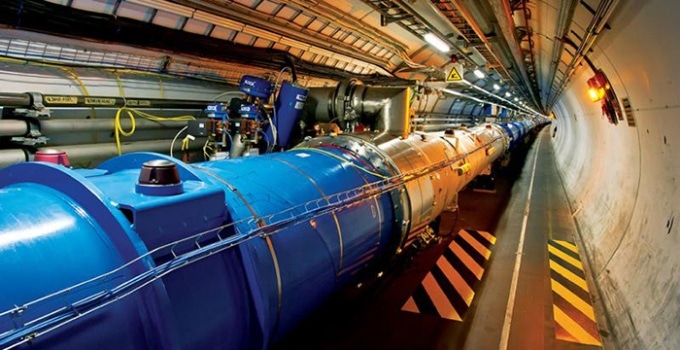Jul 29 2016
In December 2015, researchers at the Large Hadron Collider (LHC) in Europe reported surprising results that suggested the presence of a new subatomic particle, with a mass six times heavier than that of the Higgs boson. Higgs boson is a particle in the Standard Model of physics and made headlines back in 2012.
 The Large Hadron Collider, courtesy of CERN.
The Large Hadron Collider, courtesy of CERN.
Although there is not much evidence about this latest discovery, additional data could help validate the finding and improve our understanding of the universe’s building blocks.
This was a very surprising announcement and a puzzle at the same time because the lifetime and mass of the particle could reveal something else beyond simply one extra particle, if it turns out to be a real signal. Yet we do not claim this as a discovery, and we need more data.
Kyoungchul “K.C.” Kong, Associate Professor, University of Kansas
Considering the LHC findings, theoretical physicists across the globe proposed ideas that could elucidate the unknown signal and guide towards further experimentation. In this regard, the leading peer-reviewed journal in the field, Physical Review Letters received a countless number of papers claiming to explain the LHC results.
“We explore ideas,” Kong said of theoretical particle physicists. “Probably most of ideas are wrong - but we learn from them, and we propose better ideas.”
Among the hundreds of papers sent to Physical Review Letters concerning the LHC findings, the journal selected to publish just four papers, including the one that was co-authored by Kong, who actually had the novel idea about the submission.
According to the KU physicist, the mysterious signal identified at 750 GeV indicates “the first hint for new particles beyond the Standard Model.” The Standard Model of particle physics is an ancient theory employed to elucidate the subatomic particles and forces working in atoms constituting all identified matter in the universe.
He said, "Every explanation of the 750 GeV excess needs a new particle. Most models assume one around 750 GeV.”
However, Kong’s concept appeared to be different than most. Instead of building his theory on the presence of a resonance particle with a related mass to activate the 750 GeV signal, Kong’s paper recommended a series of particles at varying masses, without one at 750 GeV.
I was participating in a workshop in Korea, back in December 2015, when there was an announcement on this excess. Everyone was considering a resonance particle, which would have been my first choice. I wanted to interpret this differently and talked to some friends in the workshop, and proposed non-resonance interpretation.
Kyoungchul “K.C.” Kong, Associate Professor, University of Kansas
Kong added that his idea is based on a “sequential cascade decay” of a bulkier particle into photons that can “fake the resonance signal” at 750GeV.
It remains to be seen whether Kong’s theory will be proven, but to KU researchers Kong’s bold proposal reported in the renowned journal seems to be an unusual one.
Fundamental physics discoveries often take years, decades (see under Higgs) or even centuries (see under gravitational waves) to be confirmed. However, it is certainly a great honor for KU to have our research published in such a high-impact venue and chosen out of literally hundreds of entries from all over the world and from the most prestigious institutes in the world.
Hume Feldman, Professor and Chair of the KU Department of Physics and Astronomy
Another KU Foundation Professor Christophe Royon penned a paper that recommended an unusual mechanism to describe the observation which was later accepted by PRL. Ian Lewis, an Assistant Professor, also wrote a paper on the same subject.
“The fact that independent KU papers were accepted by PRL out of the hundreds submitted is another testament to the high-quality research done at the Department of Physics and Astronomy,” Feldman said.
Kong’s co-authors included Won Sang Cho, Myeonghun Park and Sung Hak Lim of the Institute for Basic Science in Korea; Doojin Kim and Konstantin T. Matchev of the University of Florida; and Jong-Chul Park of Korea’s Chungnam National University. At present, Kong is participating in a workshop at CERN, where Kong’s work on the mysterious results will continue. CERN is the European nuclear agency that operates the LHC.
Theorists propose ideas, and experimentalists perform experiments to test the ideas, then publish their results - and we try to understand.
Kyoungchul “K.C.” Kong, Associate Professor, University of Kansas
Other KU researchers working at the LHC include KU's Distinguished Professor Alice Bean and professors Graham Wilson and Philip Baringer, as well as postdoctoral researchers and students. A conference will be held in Chicago from 3 to 10 August 2016, where an update on the 750 GeV excess will be delivered.